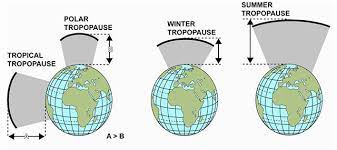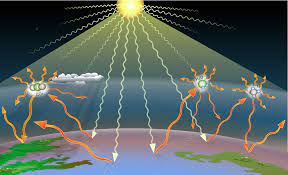Class 11 Geography NCERT Solutions Chapter 8 Composition and Structure of Atmosphere
1. Multiple choice questions.
(i) Which one of the following gases constitutes the major portion of the atmosphere?
(a) Oxygen
(c) Argon
(b) Nitrogen
(d) Carbon dioxide
Answer: (b) Nitrogen
Explanation: Nitrogen (N2) constitutes the largest portion of Earth’s atmosphere, accounting for approximately 78% of the total volume. Oxygen (O2) comes second at around 21%, followed by trace amounts of other gases like argon (Ar), carbon dioxide (CO2), and others.
(ii) Atmospheric layer important for human beings is:
(a) Stratosphere
(c) Troposphere
(b) Mesosphere
(d) Ionosphere
Answer: (c) Troposphere
Explanation: The troposphere is the atmospheric layer closest to the Earth’s surface and is crucial for human beings. It contains the air we breathe, weather phenomena, and the oxygen necessary for human and animal respiration. Most of Earth’s weather occurs in the troposphere, making it a vital layer for our daily activities and life support.

(iii) Sea salt, pollen, ash, smoke soot, fine soil — these are associated with:
(a) Gases
(b) Dust particles
(c) Water vapour
(d) Meteors
Answer: (b) Dust particles
Explanation: Sea salt, pollen, ash, smoke soot, and fine soil are examples of solid particles or dust that are suspended in the atmosphere. These particles can have various sources, including natural processes like volcanic activity and human activities such as industrial emissions and vehicle exhaust. They play a role in atmospheric processes, air quality, and can have impacts on climate and human health.
(iv) Oxygen gas is in negligible quantity at the height of atmosphere:
(a) 90 km
(b) 120 km
(c) 100 km
(d) 150 km
Answer: (b) 120 km
Explanation: Oxygen gas (O2) becomes increasingly sparse at higher altitudes in the atmosphere due to decreasing atmospheric pressure and density. Its concentration becomes negligible at around 120 km above the Earth’s surface, marking the transition between Earth’s atmosphere and outer space.
(v) Which one of the following gases is transparent to incoming solar radiation and opaque to outgoing terrestrial radiation?
(a) Oxygen
(b) Nitrogen
(c) Helium
(d) Carbon dioxide
Answer: (d) Carbon dioxide
Explanation: Carbon dioxide (CO2) is transparent to incoming solar radiation, allowing sunlight to pass through the atmosphere. However, it is relatively opaque to outgoing terrestrial radiation, particularly in the infrared wavelengths. This property contributes to the greenhouse effect, where certain gases, including carbon dioxide, absorb and re-emit heat energy, warming the lower atmosphere and the Earth’s surface.

2. Answer the following questions in about 30 words.
(i) What do you understand by atmosphere?
Answer: The atmosphere refers to the layer of gases that envelops the Earth, held in place by gravity. It’s a dynamic system crucial for sustaining life, moderating temperature, and influencing weather patterns. Comprising a mixture of gases, the atmosphere plays a vital role in regulating the Earth’s climate, protecting it from harmful solar radiation, and facilitating various meteorological processes.
(ii) What are the elements of weather and climate?
Answer: Weather and climate involve different elements. Weather refers to the short-term atmospheric conditions in a specific area, including temperature, humidity, precipitation, wind speed, and atmospheric pressure. Climate, on the other hand, encompasses the long-term patterns of weather over extended periods, involving elements like temperature averages, precipitation patterns, and seasonal variations.
(iii) Describe the composition of atmosphere.
Answer: The Earth’s atmosphere consists primarily of nitrogen (about 78%) and oxygen (about 21%), with trace amounts of other gases like argon, carbon dioxide, and neon. Water vapor, a variable component, plays a significant role in weather and climate. Suspended solid particles, dust, and aerosols are also present. The composition varies with altitude, and the atmosphere is divided into distinct layers based on temperature variations.
(iv) Why is troposphere the most important of all the layers of the atmosphere?
Answer: The troposphere is the lowest layer of the atmosphere, extending up to about 10-15 km. It’s crucial because it contains the air we breathe, weather phenomena, and life-sustaining oxygen. It’s where most weather processes occur, including cloud formation, precipitation, and storms. The troposphere’s temperature gradient influences vertical movement of air and convection, playing a pivotal role in redistributing heat and regulating the climate system.
3. Answer the following questions in about 150 words.
(i) Describe the composition of the atmosphere.
Ans: The Earth’s atmosphere is a complex mixture of gases that surround the planet. Its composition consists of various elements and compounds in different proportions. The major components of the atmosphere include:
- Nitrogen (N2): Nitrogen is the most abundant gas, making up approximately 78% of the atmosphere. It is relatively inert and plays a crucial role in supporting life and various biochemical processes.
- Oxygen (O2): Oxygen constitutes about 21% of the atmosphere. It is essential for respiration and combustion, making it vital for sustaining life and many chemical reactions.
- Argon (Ar): Argon makes up around 0.93% of the atmosphere. It is chemically inert and contributes to atmospheric pressure.
- Carbon Dioxide (CO2): Carbon dioxide is present in trace amounts, around 0.04%. It plays a critical role in the greenhouse effect and regulating Earth’s temperature.
- Neon (Ne), Helium (He), Methane (CH4), Krypton (Kr), and Xenon (Xe): These gases exist in minute quantities, often measured in parts per million (ppm) or parts per billion (ppb). They have various roles, including influencing spectral lines and serving as tracers in atmospheric studies.
- Water Vapor (H2O): The amount of water vapor in the atmosphere varies greatly, from almost 0% to around 4% by volume. It plays a fundamental role in weather and climate, being responsible for cloud formation, precipitation, and temperature regulation.
- Trace Gases and Aerosols: These include various gases like ozone (O3), pollutants, dust particles, aerosols, and particulate matter. They have localized and global impacts on air quality, weather patterns, and atmospheric chemistry.
The composition of the atmosphere can change due to natural processes like volcanic emissions, as well as human activities such as industrialization and deforestation. Overall, the delicate balance of gases in the atmosphere is essential for supporting life and maintaining the Earth’s climate system.
(ii) Draw a suitable diagram for the structure of the atmosphere and label it and describe it.
Ans:

Structure of the Atmosphere:
- Troposphere (0-12 km): The closest layer to the Earth’s surface where weather occurs. Temperature decreases with altitude. Contains most of the atmospheric mass and water vapor.
- Stratosphere (12-50 km): Contains the ozone layer that absorbs harmful UV radiation. Temperature increases with altitude due to ozone absorption of UV rays.
- Mesosphere (50-85 km): Temperatures decrease with altitude. Meteors burn up in this layer due to friction with the atmosphere.
- Thermosphere (85-600 km): Temperatures rise significantly due to absorption of high-energy solar radiation. Contains ionosphere, where ionization of gases occurs, enabling radio communication.
- Exosphere (Above 600 km): Outermost layer, transitions into space. Gases are highly dispersed. Satellites orbit within this layer.
Each layer has distinct characteristics and plays a crucial role in Earth’s processes and phenomena. The atmosphere protects us, regulates temperature, supports life, and interacts with solar radiation.
Read
